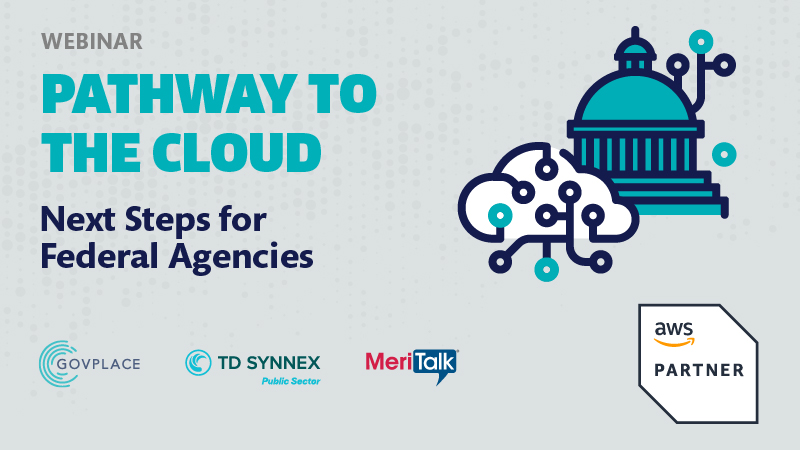
Throughout the Federal government, agencies are continuing to move to cloud infrastructures to speed IT modernization and improve cybersecurity.
Post-migration, the work is far from done. IT leaders must compare pre- and post-migration performance, continue training teams, and stay alert for potential data compromise and other issues.
During MeriTalk’s “Pathway to the Cloud: Next Steps for Federal Agencies” webinar on July 31, Joshua Stultz – a senior cloud architect and lead of the cloud operations and security team at the National Institutes of Health’s (NIH) Center for Information Technology (CIT) – said that governmentwide cloud migration is about halfway complete.
“I think we’re probably, governmentwide, probably about 50 percent of the way there – and some agencies may be 75, and some are all the way back at the very beginning,” Stultz explained. “At NIH, I think we’re halfway there. We see a lot of interest and a lot of people try to move there, and within the next three to five years I think we’re going to see it move a lot quicker.”
Stultz has become a cloud expert by working solely in the infrastructure at NIH for the last decade. Since 2020, the cloud architect has held a role within the NIH Science and Technology Research Infrastructure for Discovery, Experimentation, and Sustainability (STRIDES) Initiative – which allows the agency to explore the use of cloud environments to streamline data use by partnering with commercial providers.
NIH’s STRIDES Initiative aims to modernize biomedical research by reducing economic and process barriers in utilizing commercial cloud services. These partnerships enable access to rich datasets and advanced computational infrastructure, tools, and services.
“Cloud has become just a standard household name at this point, and it’s our go-to for everything,” Stultz said. “I thought it was going to be a fad, like many others, and it didn’t, and it’s been staying here.”
He continued, adding, “It’s been a lot of progress getting there. It’s allowed us to do things faster. It’s allowed us to do things more efficiently and very secure. It’s going to be the number one priority for most organizations in the near future” if it isn’t already.
“Here at NIH, it’s our priority from our director at CIT. They want us to move to cloud. They want us to make cloud-first methodologies. They want us to look at cloud before we look at stuff on-prem,” Stultz said. “The on-prem data centers are dying, they can’t support them. They cost millions of dollars to replace, they take a lot of cooling and infrastructure and valuable space that we need for scientific research.”
“Putting things in the cloud is kind of a no-brainer for us. And it’s going to allow us to take advantage of things like AI and ML – can’t really do that easily on-prem. But there’s plenty of those great services out in the cloud,” he explained.
Zachary Hill, senior director of strategic technology at Govplace – a premier IT solutions provider – explained that adopting the cloud is akin to an “infinity symbol” because it’s a constant evolution.
“Leveraging frameworks that help your team to really execute on this work” is crucial, Hill said.
“It’s an infinity symbol. It’s an infinity symbol for a reason too because it never ends. It’s a constant evolution. Much like we as human beings are constantly learning and growing,” he said. “The truth is that we’re never going to get it right on the first try. It’s got to be a constant iterative improvement that we really need to adopt as agencies and organizations. And to do so it’s by implementing simple processes and simple tools and simple tasks and checkpoints along the way.”
“As it comes to success in the cloud, I think, utilizing frameworks like DevSecOps, zero trust – well-architected frameworks – things like that really will help you succeed in your adoption as well as oftentimes get there faster, more secure. And also, probably check off more of your goals and success metrics along the way,” Hill said.
Having been a cloud guru at NIH over the last decade, Stultz said the best thing any agency can do is “fail fast and fail often” because “that’s the beauty of the cloud.”
“No one’s going to get it right the first time, you can’t. And that’s the beauty of cloud. You don’t have to get it right the first time. We’re not building a data center. We’re not buying equipment. We’re trying things out. It’s software as a service in reality, so you’re not spending months building out a room and cooling and adding in all this equipment,” he explained. “You’re spinning it up in the console, you’re trying it out, and if it doesn’t work, guess what? It’s simple: delete, recreate, and you get to try different things.”
Stultz continued, “It becomes a lot simpler the cloud, we have to think differently about how we do things, and we have to think differently about our outcomes. Failure isn’t a bad thing – fail fast fail often so you can get to the right product that you’re trying to do, and the right [product] that you need for your customers.”
“And then the Federal government, we have to start thinking a little bit about that because we’ve got to be able to deliver better faster. People expect that of us, the community expects that of us, and we have to be good stewards of the taxpayer dollars,” Stultz said.
MeriTalk’s “Pathway to the Cloud: Next Steps for Federal Agencies” webinar is now available for viewing on demand. Register today to access the recording and hear the experts discuss how agencies can evaluate which applications are the best fit for the cloud – and following migration, how they can determine if they are getting the most out of their cloud investments.
